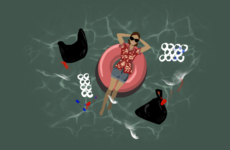
Graphic by Rielle Reyes ’27/The Choate News
By Chelsea Branch ’25
Our perception of music is constantly redefined by artists who dare to challenge convention. It is the musicians who pride themselves on originality that catch the ears of audiophiles. As music evolves to feature new singers, genres, and sounds, the art of sampling ensures that the songs of the past are brought with us to the future.
Sampling occurs when a producer or artist incorporates another musician’s work into their otherwise original piece. “Otis” by Kanye West and Jay-Z, which remixes “Try a Little Tenderness” by Otis Redding, as well as “Redbone” by Childish Gambino, which features “I’d Rather Be With You” by Bootsy Collins, are two hits that use melodic samples for the entirety of the song. “Never Lose Me” by Flo Mili, “Run the World (Girls)” by Beyoncé, “Whatcha Say” by Jason Derulo, and even “Toxic” by Britney Spears are just a few more examples of musicians singing and rapping over borrowed beats.
Some critics claim that sampling promotes unoriginality amongst artists, weakening the potency and authenticity of modern music. On the contrary, sampling was founded upon innovation, and the sheer talent required for remixing music proves otherwise. Its roots trace back to the beginnings of hip-hop when the founders of the genre, DJ Kool Herc, Afrika Bambaataa, and Grandmaster Flash, were spinning their first turntables. Their mastery of record manipulation allowed them to repurpose and remix beats, adding an unforeseen depth and attraction to the original songs. Sampling established an entirely new music genre that has since become a defining characteristic of Black and American culture.
Even contemporary artists and producers who sample songs possess undeniable creativity. Take Drake’s newest album, For All the Dogs, as an example. Several of his tracks feature sampled beats and introductions, such as “Calling For You.” On this song, Drake and his fellow producers showcased their musical ingenuity by taking the somber ballad “Livin’ Without You” by Nohelani Cypriano, splicing it, pitching it up, slowing it down, and eventually turning it into the perfect beat for 21 Savage to rap on. Likewise, “Ghost Town” by Kanye West feat. PARTYNEXTDOOR, a personal favorite, samples “Take Me for a Little While” by the Royal Jesters. This song’s sobering melody, coupled with lyrics that tell the story of a dejected lover, directly juxtaposes the cathartic crescendo of “Ghost Town.”
Sampling extends beyond the traditional concept of merely infusing another artist’s instrumental or vocal work into one’s piece; it can also invoke lyrical elements. One of the most beautiful and heart-wrenching songs of the 21st century, “White Ferrari” by Frank Ocean, is a prime example of poetic sampling. In the song’s fourth verse, Ocean uses the line “Spending each day of the year,” a lyric taken from the Beatles’ song “Here, There and Everywhere.” As Ocean wrote his album Blonde, he suffered a seemingly incurable case of writer’s block. Ocean could only overcome his creative impasse by drawing inspiration from his favorite Beatles hits. Sampling both enables originality and also allows artists to pay homage to their musical role models.
Some music lovers denounce sampling out of fear that the process is unethical. They worry that affluent musicians recklessly steal the work of minor or lesser-known creators with no repercussions. These apprehensions are undoubtedly well-founded, but fortunately, the music industry has taken several measures to ensure credit is given where credit is due.
Sampling without permission is illegal. An artist interested in remixing a snippet of another musician’s song must receive approval from both the original artist’s record label and the copyright company. These parties then negotiate deals on how the sampled artist can be compensated and credited for their contributions to the new song. Sadly, there will always be instances of corruption when it comes to creative license, but this is a reflection of the greediness of dishonorable corporations, not the art of sampling itself.
The next time you head to a SAC dance or listen to your favorite workout playlist, keep your ears peeled for sampling. If you hear a song you suspect is not the original work of the named artist, go the extra mile to find the original piece. You may find that you and your favorite artist have similar music tastes.




